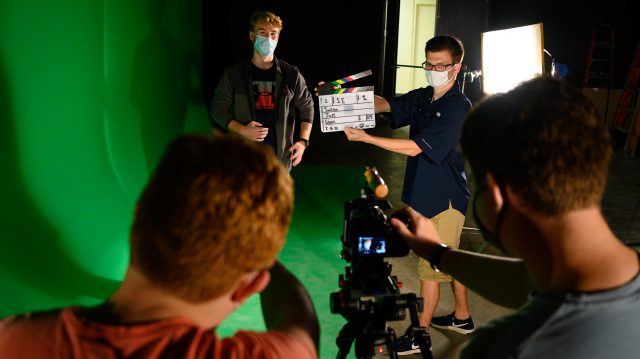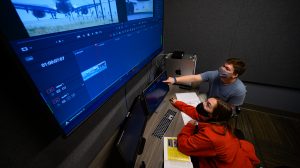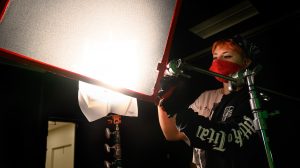
Students prepare to shoot a scene in the university’s new South Oxford Center film complex on South Lamar Boulevard. The $1.5 million facility has helped the Department of Theatre and Film add hands-on opportunities for students to gain professional experience in its bachelor’s program in film production. Photo by Robert Jordan/Ole Miss Digital Imaging Services
OXFORD, Miss. – There’s an impressive new soundstage, 20 film editing stations, sets that are built and then left in place, and ample space for costumes and makeup. There’s even a green room to read over lines, practice jokes and await that first spotlight.
This isn’t a list of amenities in a studio somewhere in Hollywood, though. Instead, it’s some of what’s available at the University of Mississippi‘s new $1.5 million South Oxford Center film complex on South Lamar Boulevard.
The new center, which opened to students this fall, benefits from the Department of Theatre and Film‘s growing bachelor’s program in film production. The new complex brings with it a classroom experience unlike anything that could have been imagined at Ole Miss just a few years ago, said Michael Barnett, the department’s chair.
“We’re really excited to add this component to what we are able to offer our students,” Barnett said. “This film production facility is going to fundamentally change how we are able to teach, as well as the practical experience we are able to give students, which is what we set out to do. We can really simulate the workflow in a professional environment.

James Hudson (top) and Kaitlyn File edit a film project in an editing bay at the the South Oxford Center film complex. Photo by Robert Jordan/Ole Miss Digital Imaging Services
“We are creating a facility unlike anything you are able to find in north Mississippi, and we are really excited to share that with the students.”
The center is a jewel in the South Oxford Center, former location of Baptist Memorial Hospital-North Mississippi. The property, which the university acquired in March 2018, provides nearly 485,000 square feet of crucial space for growing programs.
Over the next several years, the South Oxford Center will welcome new tenants, thus allowing for the expansion of multiple academic, research and service units.
As the university’s available space grew, its film program also has been growing. In 2018, UM integrated the film production major into the department’s curriculum. This involved taking the existing Bachelor of Fine Arts in acting and the existing B.F.A. in musical theater, merging the two programs and adding a screen acting component to create a B.F.A. in acting for stage and screen.
Aligning the performance program with the new film degree was essential to the creative environment the department set out to build.
In the last decade, the South has become a center of film production, and the university has benefitted from this phenomenon, said Lee Cohen, dean of the UM College of Liberal Arts.
“We’ve been fortunate to attract many talented faculty from that industry to our campus,” Cohen said. “We’ve now gone a step further by creating a new film production center, where faculty and students can work together in a sophisticated technological and creative space that enables and inspires students to master their craft.”
The new space gives students the feel of working in a professional studio space, said Alan Arrivée, associate professor of film and head of the film production program.
“Once we get into production, we will then collaborate with the actors in the department, who will then come over to the green room and put on makeup and costumes and, hopefully, remember their lines and what happened in rehearsal,” Arrivée said. “We will have lights that say we’re recording.”
The new space was transformed over the summer and began hosting students this fall when classes resumed, with COVID-19 safety parameters in place.

Ole Miss students Molly Houchin (left) and Jackson Strickland record sound effects for a film project in the foley room of the South Oxford Center film complex. Photo by Robert Jordan/Ole Miss Digital Imaging Services
“I was taken aback by how clean everything looked and how spacious it is,” Arrivée said. “I thought, ‘Wow, when we get the equipment set up and ready to go, it’s going to be such a turnaround as far as what we are able to do in film production.’
“The past is just no comparison to the future of what we can do here.”
The new center comes at a time when opportunities in the industry have expanded far outside its traditional meccas of New York and Los Angeles, Arrivée said. In recent years, Toronto, Atlanta, New Orleans, Austin, Texas, and even small-town Mississippi have been the settings for major films, and those areas have seen a growing film presence at times.
“There’s Toronto, strangely because it looks a lot like New York, but it’s cheaper to replicate it,” he said. “Then there became some smaller centers where film projects were being created off the ground, but also more projects being brought in that wanted to take advantage of the flavor or New Orleans, or small-town Mississippi, depending on the film. That’s the biggest difference.”
The ability to stay in the South and have a career in film makes places such as Ole Miss more attractive to students, Arrivée said.
“We hear students say, ‘We want to stay in the South’ or ‘We want to be fairly close to our parents,” he said. “Some 10 to 15 years ago, that would have been a very bad decision on a professional level. Now, you do have film production ongoing in New Orleans, or Nashville, and a lot of productions coming in and taking advantage of the current landscape of the South.
“It has become a much more viable career path to follow in the South. The jobs are here.”
The center will give students the same experience they’d have in the working world, but with the department’s instructors to help students grow into film production professionals, Barnett said.
The faculty and staff of the film production area worked closely with the designers and architects to create an environment that matches, as closely as possible, what one would expect to find in a professional studio. With assistance from the College of Liberal Arts and the financial support of Nancye Starnes, through the Nancye Starnes Film Production Studio Fund, Ole Miss students are able to have an experience that is unparalleled in the state.

A student sets up lighting for a shoot in the new $1.5 million UM South Oxford Center film complex. Photo by Robert Jordan/Ole Miss Digital Imaging Services
The Department of Theatre and Film has grown over the last few years, Barnett said. He attributes it to the revamped programs, new facility and the strong faculty.
“We’ve seen a lot of interest in our new program,” Barnett said. “We accept no more than 16 students in the film production area each year so they can have the opportunity to come out of a B.F.A. program with the experiences necessary to be successful in the industry.
“We are excited by the growth that we have seen in the film production area, as well as the department overall, and continue to strive to maintain a close-knit learning experience which is essential to an artist’s development. Students get to work closely with a very high-quality faculty.”